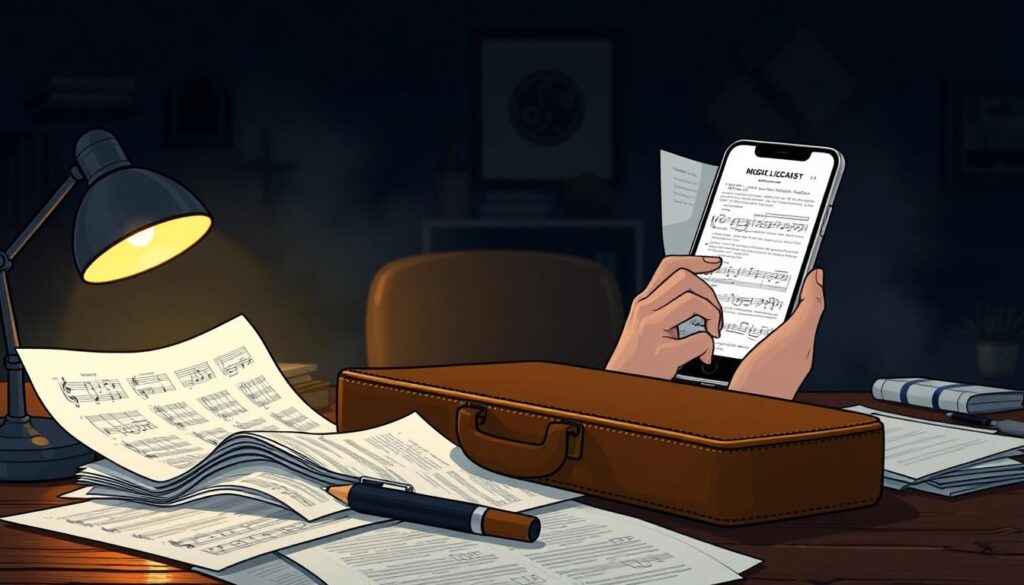What makes the perfect background music for your project or event? Can ambient music really elevate the overall experience, or is instrumental music the way to go? With so many options available, choosing the right background music can be overwhelming.

Background music is key for videos, presentations, or websites. It sets the tone and atmosphere. In this article, we’ll explore the importance of background music. We’ll also give you a comprehensive guide on how to select the perfect tracks for your needs.
Key Takeaways
- Understanding the role of background music in enhancing the overall experience
- Learning how to choose the right ambient music for your project
- Discovering the impact of instrumental music on audience engagement
- Exploring the different types of background music for various settings
- Finding the perfect balance between music and content
- Learning about legal considerations and music licensing
- Getting tips on how to implement background music effectively
Understanding the Role of Background Music
Background music is key in setting the mood for a project. It can make a video, website, or presentation more engaging. Royalty-free music is great for websites because it’s affordable and easy to use. Choosing the right music helps create the desired atmosphere.
When picking background music, think about tempo, genre, and volume. Tempo affects the project’s energy and speed. Genre shapes the mood. The volume should complement the main content, not overpower it. Good background music makes your project more engaging and immersive.
- Enhances emotional impact and engagement
- Sets the tone and atmosphere
- Creates a more immersive experience
- Can be cost-effective with royalty-free music
Understanding background music’s role helps you pick the right music. This makes your project more engaging and effective for your audience.
Types of Background Music for Different Settings
Choosing the right background music depends on the setting. For example, relaxing background music is great for spas or wellness videos. It creates a calm atmosphere. On the other hand, cinematic background music is best for movie trailers or promotional videos. It adds excitement and drama.
Here are some common types of background music and their ideal settings:
- Corporate videos: upbeat background music to show energy and professionalism
- Wedding videos: romantic background music to set a loving tone
- Travel videos: adventurous background music to capture the spirit of exploration
Think about the mood and atmosphere you want to create when picking background music. Cinematic background music adds depth and emotion. Relaxing background music helps viewers unwind and focus.
Choosing the right background music can improve the viewing experience. It engages your audience more effectively. Whether it’s for a commercial, educational, or entertainment video, the music can make a big difference. It helps convey your message and leaves a lasting impression.
Essential Elements of Effective Background Music
Creating background music for videos requires careful thought. The right music can enhance the mood and feel of a video. On the other hand, bad music can ruin the experience. We’ll explore the key elements of great background music, like tempo, rhythm, volume, and genre.
Finding the perfect instrumental music for your video can be tough. There are so many choices out there. Here are some tips to help you:
- Tempo: The speed of the music affects the video’s energy and pace.
- Rhythm: The pattern of sounds and silences can add tension or calmness.
- Volume: The music’s loudness or softness impacts how the audience feels.
- Genre: Different genres of music for videos can create different moods.

By thinking about these elements, you can make a background music that fits your video well. It will also connect with your audience.
How to Match Background Music to Your Content
When making a presentation, video, or website, picking the right background music is key. Background music for presentations should be soft but interesting to keep viewers engaged. For websites, background music for websites should be catchy and easy to remember to improve the user’s experience.
To find the perfect background music, think about a few things:
- Audience: Who are you making this for, and what kind of music will they like?
- Tone: Is your content formal, casual, serious, or funny?
- Mood: Do you want to make your audience feel energetic, calm, or inspired?
By keeping these points in mind, you can pick music that makes your content better. For instance, a presentation about a new product launch might use lively music. A website about meditation and wellness could have calming tunes.

Finding the right music for your content is all about balance. The music should support your message without taking over. With the right background music, you can make your audience’s experience memorable and enjoyable.
Legal Considerations and Music Licensing
Using background music requires understanding legal aspects and music licensing. Royalty-free music is a good choice for avoiding licensing issues. It’s key to know about copyright law and the differences between royalty-free and licensed music.
Music licensing platforms make it easier to use music legally. They offer a variety of music, including royalty-free music. These platforms give the needed licenses for different uses.

Here are some key things to consider when it comes to music licensing:
- Understand the terms of the music license and what is allowed
- Choose music that is suitable for your content and audience
- Consider the cost and budget for music licensing
By understanding legal aspects and music licensing, you can use background music legally and effectively. Music licensing might seem complex. But with the right knowledge, it can be easy.
Technical Aspects of Background Music Implementation
Implementing background music in your project involves several technical aspects. Choosing the right file format is key. It ensures your music sounds great and plays smoothly. For videos, MP3 and WAV are top picks. Compression also plays a big role in your music’s quality.
To ensure smooth playback, keep these tips in mind:
- Choose a file format that works with your media player or video editing software
- Optimize your background music file size for web use to reduce loading times
- Use a consistent volume level throughout your background music track

Think about your background music’s playback settings. This includes setting the right tempo and rhythm. By focusing on these details, you can make your background music sound professional and enhance your video.
For those making music for videos, understanding technical aspects is crucial. By following these guidelines and choosing the right file format, compression, and playback settings, you can create high-quality background music. This music will elevate your video content and engage your audience.
Common Background Music Mistakes to Avoid
Creating a soundtrack for your content is key. The right background music can make it great. But the wrong music can mess it up. Let’s look at common mistakes to avoid.
Volume balance is a big issue. It can be jarring and ruin your content’s flow. Proper volume levels are essential. They make sure the music doesn’t drown out other sounds.
Also, picking the wrong music genre can be a problem. It can make your content feel disjointed. You want your music to match your content’s mood and style.
- Choose background music that complements the tone and atmosphere of your content
- Ensure that the volume levels are balanced and consistent throughout
- Pay attention to genre and style to create a cohesive soundtrack
By focusing on these points, you can make your content more engaging. The right ambient music can really enhance your message.
Where to Find Quality Background Music
Finding the right background music for your project can be tough. There are so many choices out there. Let’s look at some top places to find great background music. You can find everything from instrumental tracks to music that complements your content.
Music libraries are a great place to start. They have a wide selection of instrumental music and background music. These libraries offer high-quality music made for different projects like videos, podcasts, and presentations.
There are also subscription services that give you access to lots of background music. They’re easy to use and can save you money. Some well-known services include:
- Audioblocks
- Epidemic Sound
- Shutterstock Music
If you want something unique, consider custom music composition. It’s a way to get music that’s made just for your project.
By checking out these resources, you can find the perfect background music. Whether you need instrumental or background music, there are many quality options to choose from.
Best Practices for Background Music in Different Media
Choosing the right background music for presentations is key. It should match the message and tone of your presentation. The right music can grab the audience’s attention and make your message clearer.
For websites, the approach is different. The music should be soft and not get in the way. It should let visitors enjoy the site without distraction. Good background music can make a website more fun to explore.
Here are some tips for using background music in various media:
- Keep the volume low to avoid overwhelming the audience
- Choose music that fits the content and tone of your presentation or website
- Make sure the music is licensed and royalty-free to avoid copyright issues
By following these tips and picking the right music, you can make your media more engaging. This will help your audience enjoy and understand your content better.
Conclusion: Creating the Perfect Background Music Experience
Creating the perfect background music is like a fine art. It needs a mix of different elements. By picking the right background music, you can make your project or event better. This makes your audience more engaged.
When you’re making a video, hosting an event, or creating an online experience, the music for videos matters a lot. Think about the music’s genre, tempo, and volume. This ensures it fits well with your content without taking over.
This guide has given you the knowledge to create amazing background music. Now, go ahead and try new things. Let music take your work to new levels. Your audience will love the immersive and memorable experience you’ve given them.
Get Startup Business Loans Even With No Revenue
FAQ
What makes good background music?
Good background music makes your project feel better. It should not overpower the content. It should match the mood and emotions you want to share.
How does background music affect audience engagement?
Background music greatly affects how people feel and pay attention. It changes how they see and feel about what you’re showing.
What are the different types of background music for different settings?
The right music changes with the setting. For example, a spa needs calming music, while a movie trailer needs something more dramatic.
What are the essential elements of effective background music?
Key elements include tempo, rhythm, volume, and the music’s style. These decide how the music feels and affects your project.
How can I match background music to my content?
Choosing music that fits your content is key. Think about who you’re making it for, the mood, and what you want to say.
What are the legal considerations and music licensing requirements for using background music?
Music laws and licenses can be tricky. Know about copyright, the difference between free and licensed music, and where to find licenses.
What are the technical aspects of background music implementation?
Getting music to work right involves file types, how it’s compressed, and how it plays. Make sure it sounds good and plays smoothly.
What are some common background music mistakes to avoid?
Avoid issues like wrong volume, music that doesn’t fit, and bad loop points. These can mess up the music’s flow.
Where can I find quality background music?
You can find great music in music libraries, subscription services, or by getting it custom-made. Each has its own benefits and drawbacks.
What are the best practices for using background music in different media?
Using music in presentations, videos, and websites needs different approaches. Think about what each medium needs and follow its rules for music.











